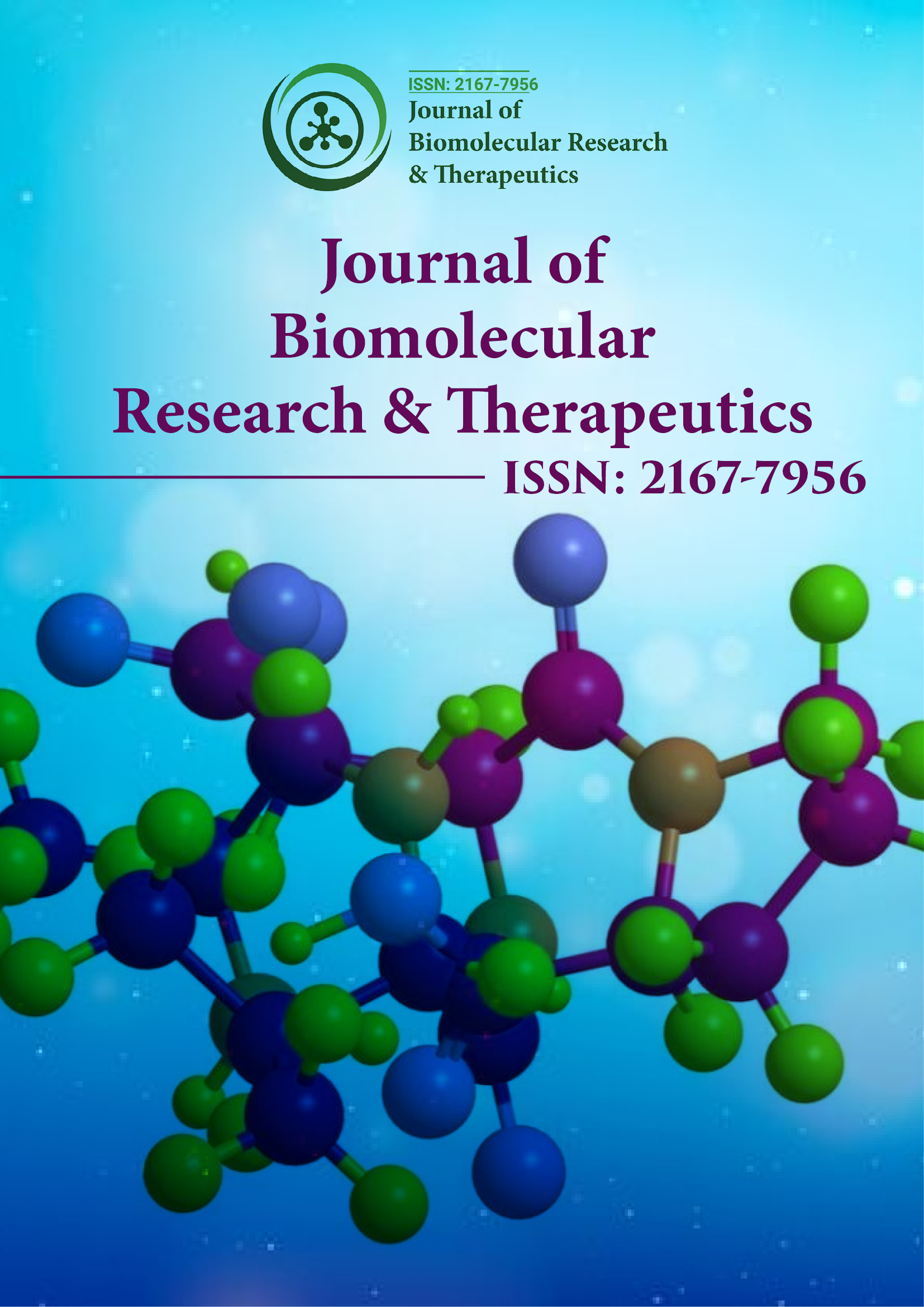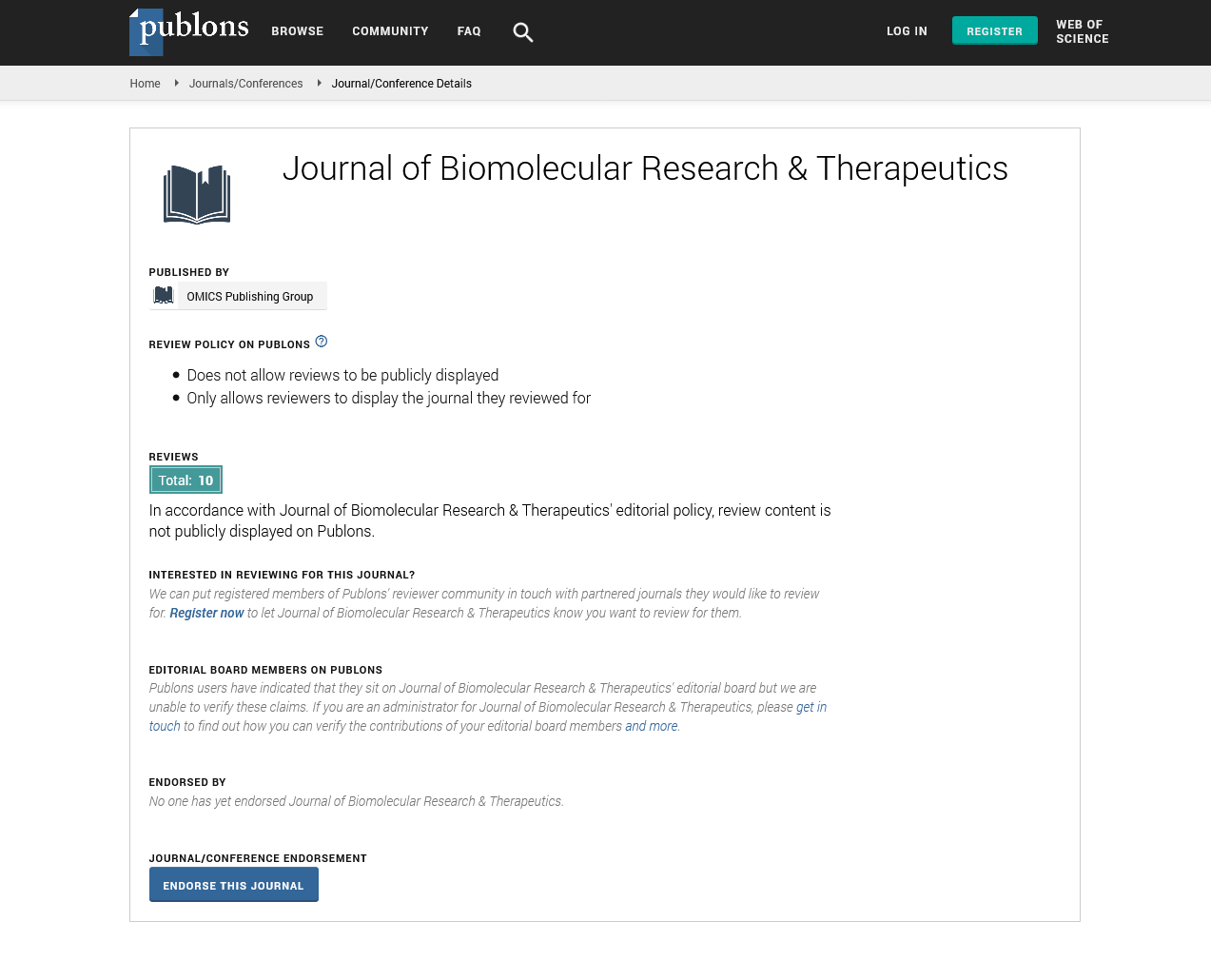Indexed In
- Open J Gate
- Genamics JournalSeek
- ResearchBible
- Electronic Journals Library
- RefSeek
- Hamdard University
- EBSCO A-Z
- OCLC- WorldCat
- SWB online catalog
- Virtual Library of Biology (vifabio)
- Publons
- Euro Pub
- Google Scholar
Useful Links
Share This Page
Journal Flyer

Open Access Journals
- Agri and Aquaculture
- Biochemistry
- Bioinformatics & Systems Biology
- Business & Management
- Chemistry
- Clinical Sciences
- Engineering
- Food & Nutrition
- General Science
- Genetics & Molecular Biology
- Immunology & Microbiology
- Medical Sciences
- Neuroscience & Psychology
- Nursing & Health Care
- Pharmaceutical Sciences
Opinion Article - (2024) Volume 13, Issue 3
Proteomics in Drug Development: Identifying Innovative Therapeutic Targets and Biomarkers
Lidschreiber Teixeira*Received: 03-Jun-2024, Manuscript No. BOM-24-26508; Editor assigned: 05-Jun-2024, Pre QC No. BOM-24-26508 (PQ); Reviewed: 19-Jun-2024, QC No. BOM-24-26508; Revised: 26-Jun-2024, Manuscript No. BOM-24-26508 (R); Published: 03-Jul-2024, DOI: 10.35248/2167-7956.24.13.390
Description
Proteomics, the large-scale study of proteins, is a vital and dynamic field in modern biomedical research. Proteins are fundamental to virtually every biological process, serving as enzymes, structural components, signaling molecules, and much more. Understanding the proteome, which is the entire set of proteins produced or modified by an organism or system, provides deep insights into cellular function, disease mechanisms, and therapeutic possibilities. In drug development, proteomics plays a major role in identifying innovative therapeutic targets and biomarkers, thus driving the discovery and development of new treatments.
Role of proteomics in drug development
Proteomics allows researchers to examine protein expression, structure, function, and interactions comprehensively.
Identification of therapeutic targets: Proteomics helps identify proteins that play major roles in disease processes. By understanding which proteins are dysregulated in disease, researchers can pinpoint potential targets for therapeutic intervention.
Biomarker discovery: Proteomic studies can reveal biomarkers, which are proteins that indicate the presence or progression of a disease. Biomarkers are essential for early diagnosis, patient stratification, and monitoring therapeutic responses.
Mechanistic insights: Proteomics provides detailed information about cellular pathways and mechanisms. This knowledge can elucidate how drugs affect cellular processes and help in designing more effective and targeted therapies.
Techniques in proteomics
Several sophisticated techniques are employed in proteomics to analyze proteins at various levels:
Mass Spectrometry (MS): This is the essential of proteomics, enabling the identification and quantification of proteins in complex samples. MS can analyze post-translational modifications and protein-protein interactions, providing a comprehensive proteomic profile.
Two-dimensional Gel Electrophoresis (2-DE): This technique separates proteins based on their isoelectric point and molecular weight, allowing for the resolution of thousands of proteins in a single experiment.
Protein microarrays: These are used to study protein interactions and functions on a large scale, offering high- throughput capabilities for detecting biomarkers and therapeutic targets.
Bioinformatics tools: Computational methods are essential for analyzing large proteomic datasets, identifying patterns, and making biological sense of the data.
Identifying innovative therapeutic targets
Proteomics is instrumental in identifying novel therapeutic targets by revealing proteins and pathways implicated in disease. Here’s how it contributes to various stages of drug development:
Disease pathway elucidation: By comparing the proteomes of healthy and diseased tissues, researchers can identify proteins that are differentially expressed. These proteins often represent critical nodes in disease pathways, serving as potential targets for intervention.
Target validation: Proteomics allows for the validation of candidate targets by studying their expression, function, and interactions. Understanding the biological role of a protein in disease is crucial before it can be considered a viable therapeutic target.
Post-Translational Modifications (PTMs): Many diseases are associated with aberrant PTMs, such as phosphorylation, acetylation, and glycosylation. Proteomics can identify these modifications, revealing new targets that might not be evident at the genomic or transcriptomic levels.
Biomarker discovery and validation
Biomarkers are critical in drug development for diagnosing diseases, predicting therapeutic responses, and monitoring treatment outcomes. Proteomics excels in discovering and validating biomarkers due to its ability to provide detailed and quantitative protein profiles.
Early diagnosis: Proteomic biomarkers can indicate the early onset of diseases before clinical symptoms appear, allowing for timely intervention. For instance, identifying early-stage cancer biomarkers can significantly improve patient outcomes.
Patient stratification: Biomarkers can classify patients based on their likely response to a particular therapy. This stratification is essential for personalized medicine, ensuring that patients receive the most effective treatment based on their unique proteomic profile.
Monitoring disease progression and treatment response: Proteomic biomarkers can track disease progression and therapeutic efficacy, providing real-time insights into how a patient is responding to treatment. This capability is crucial for adjusting therapeutic strategies and improving patient management.
Conclusion
Proteomics is revolutionizing drug development by providing a deep and comprehensive understanding of the protein landscape in health and disease. Through the identification of innovative therapeutic targets and biomarkers, proteomics is driving the discovery of new treatments and improving disease diagnosis and management. As technology advances and our knowledge of the proteome expands, proteomics will undoubtedly continue to play a pivotal role in the future of medicine, offering new hope for tackling some of the most challenging diseases.
Citation: Teixeira L (2024) Proteomics in Drug Development: Identifying Innovative Therapeutic Targets and Biomarkers. J Biomol Res. 13.390.
Copyright: © 2024 Teixeira L. This is an open-access article distributed under the terms of the Creative Commons Attribution License, which permits unrestricted use, distribution, and reproduction in any medium, provided the original author and source are credited.

